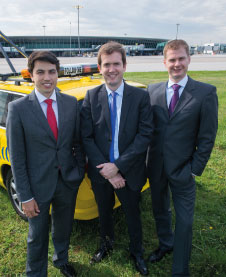
Martín, Bessard and Laukenmann spoke passionately about working in the airport sector; they each demonstrated a forward-thinking vision and the ability to develop dynamic business plans.
Our interview subjects represent three different airports, of varying sizes. Alberto Martín (37) is Managing Director of Gran Canaria Airport, which handled around 10 million passengers in 2012; Lionel Bessard (37) is Chief Operating Officer of Aéroports de Lyon, which welcomed 8.5 million passengers last year; and Alexander Laukenmann (39) is Senior Vice President, Corporate Development, Sustainability and Environment Management, Fraport AG – its Frankfurt hub handled 57.5 million passengers in 2012.
Martín, who was appointed Vice-Chair of the ACI EUROPE Regional Airports Forum on the day of our interview, has extensive airport experience attained from a career spent with Aena since 1999. His progression within the Aena Aeropuertos portfolio saw him named Director of El Hierro Airport in 2007, at the age of 32, before becoming Director of Fuerteventura Airport later that year. Martín was then appointed Director of Gran Canaria Airport in May 2011. “All of these airports have common factors; for example, they all make a contribution to connectivity. Gran Canaria Airport is fundamental to the social and economic development of the islands, and to the movement of the islanders,” stated Martín.
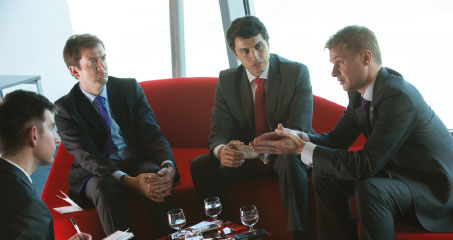
Laukenmann: “Fraport nowadays is completely different to 12 years ago. It is still majority owned by public owners, but also now has private stakeholders, so we have to satisfy different interests.”
Before entering the airport industry, Laukenmann was a banker for six years, working as a credit analyst. In 2000, he had the opportunity to participate in the Fraport IPO (Initial Public Offering), and was soon also running projects in Lima and Hong Kong. “It was just perfect; opportunities were there and if you were willing and daring enough, you could shape these projects and learn from them. I was 26 and was involved in very interesting projects that in normal business, especially at that time in banking, you would never get your hands on,” said Laukenmann. “While other industries are shrinking, aviation is still growing and creating jobs, and that’s something very valuable nowadays. For example, FRA now provides direct employment for 78,000 people and ranks as Germany’s largest employment complex at a single location. It’s good being in a business that is still able to realise projects, realise investments and create opportunities.”
Prior to his present role with Fraport, Laukenmann was General Manager of ICF Airports – the terminal operator at Antalya Airport. He held that position between March 2009 and October the 10-25 million passengers category.2012, when he took up his current role. ICF Airports is Fraport’s largest international subsidiary, with annual revenue of €300 million and 450 direct employees. Antalya Airport enjoyed consistently strong growth during Laukenmann’s tenure; double-digit increases in passenger traffic were recorded in 2010 (+18.8%) and 2011 (+14.1%) and throughput currently stands at around 25 million passengers a year. Indeed, in 2011, Antalya Airport received the ACI EUROPE Best Airport Award in the 10-25 million passengers category.
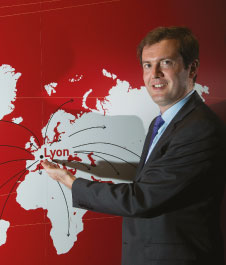
Bessard: “There is a significant crossover between operational and institutional issues within the airport industry because of the large overlap between local and national authorities and other public services.”
Laukenmann described Turkey as a “dynamic economy”, with a government that is “very supportive” of airports and airlines. Frankfurt Airport, on the other hand, is a “master of efficiency on a limited space”, with a carefully defined strategy more suited to a mature economy compared to the booming conditions of Turkey.
Bessard’s career, meanwhile, began in the French public service, in the Department of Public Works: “It was less sexy than the airport industry, but there were similar operational issues.” His experience is both operational and institutional, having worked at the European Commission and also been advisor to the French Minister of Transport Jean-Claude Gayssot, between 1998 and 2001. “There is a significant crossover between operational and institutional issues within the airport industry because of the large overlap between local and national authorities and other public services,” he said. “Indeed the nuts and bolts of running an airport are very similar to the workings of a city – some are physically the same size – many airport employment sites are much bigger than city populations and obviously more interdependent and – being one of the managers of an airport is like working for the government of a very well-run model city.”
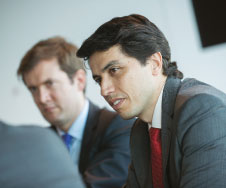
Martín: “Gran Canaria Airport is fundamental to the social and economic development of the islands, and to the movement of the islanders.”
Competitive environment
The challenging, competitive nature of the airport industry was a common theme throughout the interview, and one that was universally highlighted as being the most attractive, exciting element of working in the sector. Martín commented: “We are living and working in the most economically-volatile conditions that have been known for decades. We must innovate; flexibility is our key tool, as is creativity – all businesses have these challenges in common, not just airports, but because airports are especially large and expensive to run, the sheer scale of our tasks is exceptional.”
The fresh perspectives being applied include a more inquisitive nature, and a greater emphasis on clearly communicating the benefits of airports to their particular regions in terms of generating jobs, economic growth and connectivity. “We have very professional, experienced colleagues, and perhaps what we can bring as young executives is to go further in terms of questioning habits and the way we do things,” said Bessard. “But we don’t fear going further. We know there are limits, but as we are in a the most difficult economic times now, we don’t have the choice – executives in the airport industry must go further, otherwise you can fail in this environment – and there are plenty of examples of air transport companies which have failed in recent years.”
Laukenmann added that new outlooks centre on a partnership approach to addressing the pressures being faced in Europe’s airports sector. “What I experienced entering this business was a very clear separation between airlines and airports. What I believe is changing now is that it’s really more of a partnership. The situation we are facing at the moment – at least from the Frankfurt perspective – is not competition between one airport and another, but between airport-airline systems,” he explained. “That means, for example, with Frankfurt we’re talking about our main customers, plus Frankfurt Airport competing mainly against the hubs and airlines to the East. The real competition for us is coming from the East, with huge airport expansion and very strong airlines, and countries that regard aviation as a strategic national imperative. So, together with our customers, we must find a way to be competitive and successful in the future.”
The liberalised European aviation market means airports are competing for traffic, with airlines, particularly the low-cost carriers, able to relocate their operations between airports very quickly. Laukenmann explained that although Frankfurt primarily serves as a high-performance intercontinental hub, it is also under pressure like other hubs, as travellers do not mind which hub they use – price and service are the key factors. “It’s a very tough competition and just providing the infrastructure alone is not sufficient any more. Airports must focus on what they can bring to that specific airline, and why they should bring their hub or service to your airport. And, of course, airports must also think about the passenger experience,” he said.
The German Aviation Tax introduced in 2011 is another challenge. “The winners in all of this are Asia, the Gulf and the Middle East, because they are supporting their airlines and airports in a way that is really a competitive advantage for them. The European airports, big or small, are in the same boat – they are facing regulations and additional costs that those outside the EU are not facing,” stated Laukenmann.
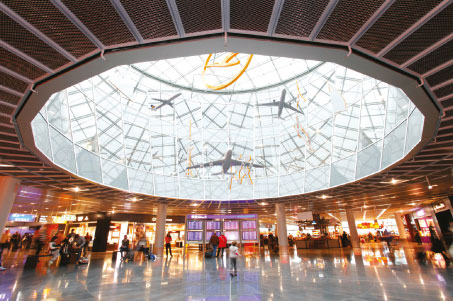
The new Pier A-Plus at Frankfurt Airport – an extension of Terminal 1 – opened in 2012. It was designed to create a stress-free atmosphere for passengers.
Martín believes that the growth in Asia and Latin America also has potential for European airports to increase traffic to those regions. He also states that Spain has a strategic location and Aena Aeropuertos is being successful in increasing this traffic as a connection point. “In Spain, we believe that we have good airports, with good infrastructure and we can offer capacity. So, in Spain, it’s more a case of competing destinations rather than just competing airports. Our marketing plans bear that in mind. We have a strategic location between Europe and Africa, and we are promoting new routes to Africa. We now have 13 routes to Africa and more than 120 to Europe, and there is potential to further develop this traffic,” he commented. “Capacity is vital – you must have sufficient capacity if you want to attract new traffic. We are working hard at that; at Gran Canaria we are investing €200 million in a terminal extension.”
Aéroports de Lyon also has a small Air France hub, and is competing with other European regional airports. “The biggest competition is to attract airlines,” commented Bessard. “We have moved to more marketing and more customer-focused decisions, because before we were not like a hub, but a regional airport with a natural monopoly – that is simply not the case any more.”
Liberalised market
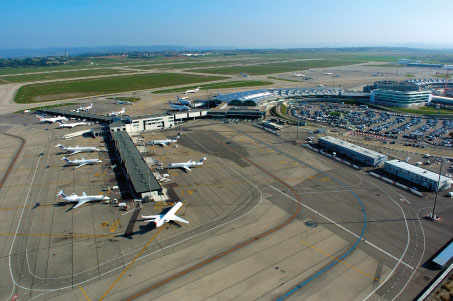
Aéroports de Lyon has a small Air France hub, and is competing with other European regional airports. Bessard: “The biggest competition is to attract airlines.”
The transformation of Europe’s airports over the past 20 years, in a liberalised market and with increasing private sector involvement, means they are now fully-fledged businesses. Laukenmann has first-hand experience of this, from his work on the Fraport IPO process completed in June 2001. “It’s not always an easy transformation, because suddenly a proportion of your shareholders are investment funds and they want a return on their investment as quickly as possible,” he commented. “Fraport nowadays is completely different to 12 years ago. It is still majority owned by public owners, but also now has private stakeholders, so we have to satisfy different interests. The public owners also want good infrastructure for the region with a balanced approach to the environment and sustainability; other stakeholders want mainly dividends and stock price increases.”
In contrast Aéroports de Lyon is a publicly owned company – 60% owned by the French State, 25% by the Lyon Chamber of Commerce and 15% by three local authorities. “We have to be self-sufficient financially-speaking, and coupled with the fact that we are a fully-fledged business, that means we have to be more innovative to generate new sources of revenues. We have to optimise the management of every single piece of our business, including commercial revenues,” explained Bessard.
Aena Aeropuertos was created in June 2011, when Aena’s airports and air navigation activities were separated. It is the world’s largest airport operator, managing 46 airports and two heliports in Spain. “Of course we are not just infrastructure providers, and we are not just businesses – we are a more complex industry, but one that is totally fundamental to the whole economy’s prosperity,” commented Martín. “If we focus on the business aspect, we are going through a period of huge uncertainty and there are many external forces over which we have little control, like the period of recession we are going through. This has, in some way, encouraged us to implement different business plans to minimise costs, to maximise our incomes and also to meet the challenge of continuing to provide a high level of service, which is our final mission.”
Enhancing the passenger experience
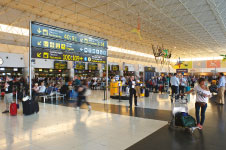
Martín: “Capacity is vital – you must have sufficient capacity if you want to attract new traffic. We are working hard at that; at Gran Canaria we are investing €200 million in a terminal extension.”
There is a unanimous desire to provide a memorable experience for passengers travelling through each of the airports. The new Pier A-Plus at Frankfurt Airport – an extension of Terminal 1 – opened in 2012. It features a walkthrough duty free store, recreation areas for children, ample seating (even for A380 flights) and quick transfers between short and long haul flights – the aim being to create a stress-free atmosphere. In December 2010, Fraport launched its ‘Great to have you here!’ customer service initiative, signalling its long-term commitment to enhancing the passenger experience. The programme follows every step along the travel process and aims to increase the level of service and provide a warm welcome to passengers. There has been an emphasis on reducing waiting times at security checkpoints in the terminals, with more than 90% of passengers now queuing for less than 10 minutes. There has also been a focus on improving signage and wayfinding. This year, FRA was recognised by Skytrax as the ‘World’s Most Improved Airport’, which underscores its efforts to find innovative ways to meet the increasing expectations of passengers.
Gran Canaria similarly strives for a smooth passenger process and welcoming atmosphere. As a touristic airport, Martín explained that it provides the all-important first and last impression of the destination. Martín highlighted the immediate, tangible results that are seen when making enhancements to the passenger experience: “We are in direct contact with our customers and their needs. We can see immediate results from the decisions we make – that is an important point. We are working to provide a smooth passenger process through our airport. We have to analyse passenger preferences and ensure that they enjoy travelling through our airports – new technologies are important in achieving this.”
Aéroports de Lyon, meanwhile, is increasingly using mobile communications to stay in touch with passengers, and to also create a real sense of place, with a local flavour. “We must achieve excellence in the basic services provided to passengers, and we must be creative and provide a unique experience to differentiate ourselves from other airports,” said Bessard. It is a successful strategy; in 2010, Aéroports de Lyon won the ACI EUROPE Best Airport Award in the 5-10 million passengers category.
Commitment to local communities
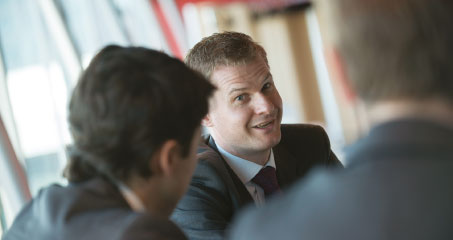
Laukenmann explained that although Frankfurt primarily serves as a high-performance intercontinental hub, it is also under pressure like other hubs, as travellers do not mind which hub they use – price and service are the key factors.
While endeavouring to provide sufficient capacity and the facilities to enable a smooth, stress-free travel experience, Europe’s airports are committed to sustainable development and to being responsible neighbours. Frankfurt Airport was the very first to become Airport Carbon Accredited in September 2009 and is now certified at the Optimisation level of the programme. Noise protection is also a key issue at Frankfurt and a number of noise abatement measures are in place. “This is now an important factor as it decides elections and puts a lot of political pressure on all parties,” said Laukenmann. “That means a very open and transparent communication, and very attractive programmes in order to compensate local residents who suffer from aviation noise. At the same time, we have to clearly communicate the social and economic advantages of airports to their regions, and the sustainability initiatives being undertaken. Fraport has a €300 million fund for buying houses in areas very close to Frankfurt Airport and suffering from noise.”
Lyon-Saint Exupéry Airport also recently became Airport Carbon Accredited at the Mapping level of the programme. Sustainable operations are a priority for Aéroports de Lyon, with a particular focus on reducing carbon emissions. Lyon-Saint Exupéry Airport is on course to progress to the Reduction level of Airport Carbon Accreditation this year, and will launch an action plan to achieve the Optimisation level by late-2015.
The buzz inside an airport – driven by the movement of people and the connectivity – has a clear appeal to each of our interviewees. In a fast-moving, fast-changing industry, these young airport executives demonstrated to us that they have developed the agility to adapt to changes, and to develop the dynamic business plans. But, most importantly they all have the passion, hope and vision which are essential to steering Europe’s airports through the most challenging economic times in living memory.







